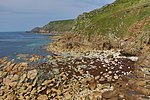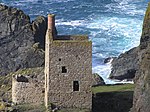Cape Cornwall

Cape Cornwall (Cornish: Kilgoodh, meaning "goose back") is a small headland in West Cornwall, England. It is 4 miles (6.4 km) north of Land's End near the town of St Just. Until the first Ordnance Survey in the early 19th-century, Cape Cornwall was believed to be the most westerly point in Cornwall.Most of the headland is owned by the National Trust. National Coastwatch has a look-out on the seaward side. The only tourist infrastructure at present is a car park (owned by the National Trust), public toilets, and a refreshments counter during the summer. The Brisons, two offshore rocks, are located approximately 1 mi (1.6 km) southwest of Cape Cornwall. They mark the starting line of the annual swimming race ending at Priest Cove.
Excerpt from the Wikipedia article Cape Cornwall (License: CC BY-SA 3.0, Authors, Images).Cape Cornwall
Geographical coordinates (GPS) Address Nearby Places Show on map
Geographical coordinates (GPS)
| Latitude | Longitude |
|---|---|
| N 50.127 ° | E -5.706 ° |
Address
TR19 7NN
England, United Kingdom
Open on Google Maps










